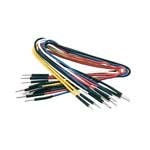 A
typical jumper cable is shown to the right. These are actually a commercial
form from JameCo (part number 126359)
You will notice that they have pins on both ends.
A
typical jumper cable is shown to the right. These are actually a commercial
form from JameCo (part number 126359)
You will notice that they have pins on both ends.Jumpers for Prototyping
February 15th, 2002
"Hey, where'd you get those cool jumpers?" Is a question I get quite often. The cables in question are the wires I use to hook things like the BASIC Stamp 2 to a proto-board. The answer is, I make them myself. It isn't hard, and you can't actually buy them anywhere so you don't really have a choice now do you?
 A
typical jumper cable is shown to the right. These are actually a commercial
form from JameCo (part number 126359)
You will notice that they have pins on both ends.
A
typical jumper cable is shown to the right. These are actually a commercial
form from JameCo (part number 126359)
You will notice that they have pins on both ends.
That's great if you're going to be wiring up stuff on a typical proto-board but most microcontroller boards use jumper blocks, not jumper sockets (note that Fred Martin resisted this trend with the Miniboard and Handyboard).
Anyway, I searched for a long time to find a way to make a jumper that was a socket on one end and a pin on the other end. That would let me plug jumper block pins found on microcontrollers into a proto-board. I was finally successful using the pins sold for DB25 connector hoods. Yup, those make your own serial cable kind of things.
From Mouser Electronics I ordered a bag of #571-7486104 crimp on sockets and a bag of #571-7483334 crimp on pins. To build a cable you decide if you want it socket-socket, pin-pin, or pin-socket and get the appropriate crimp-ons. Next you cut a length of 24AWG wire, and cut two .75" pieces of small heat shrink (3/32" or 1/8" works great). Crimp on the connectors, then slide over the heat shrink and shrink it. Leave about 1/4" of pin exposed but on the socket end line the heat shrink right up to the edge. Voila' you've got a cool jumper cable.
Now for the stuff you don't know but need to :-)
Pick the same color wire for each type of jumper (pin/pin, pin/socket, socket/socket), that way when you grab one out of your tool box you'll know what you're getting.
At each end of the cable, use a marker to draw a number of evenly spaced lines around the insulation area. This banding allows you to locate the other end when you're connecting multiple cables together. If you are really tricky you can use wide and narrow lines, or adhesive "flags."
Don't try to force the connector socket over a pin, if it isn't going smoothly then you aren't lined up!
Keep these simple rules in mind and you'll get a great deal of use out of these cables.